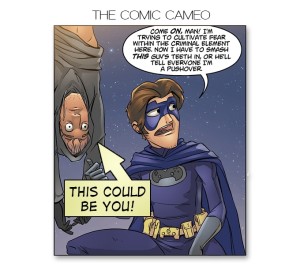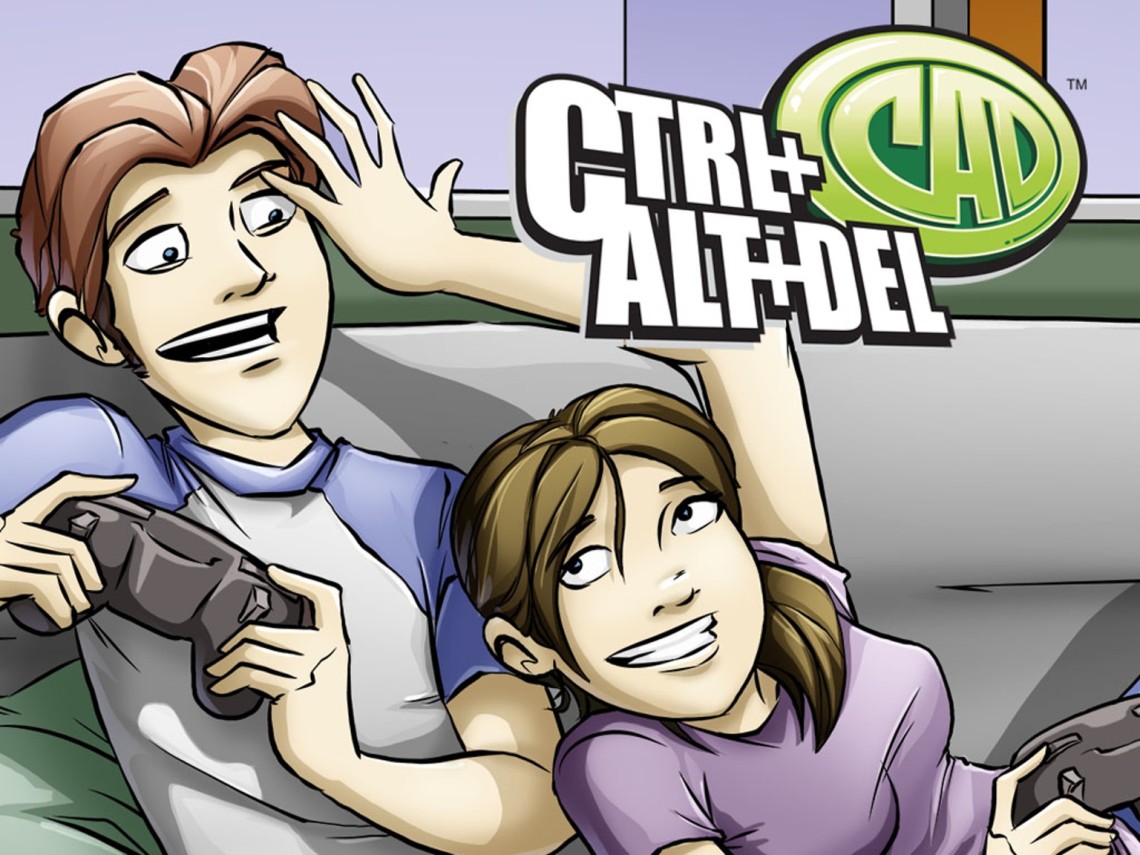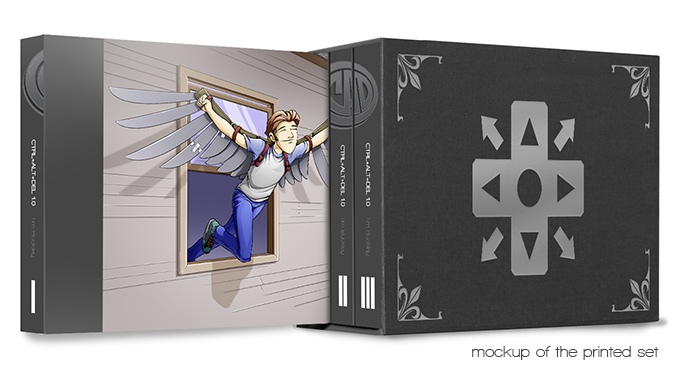There have been almost 6,700 launched comic projects on Kickstarter.
Of those, only half are successful.
And of the successful projects, only 1.5% raise six figures or more.
These campaigns are the vanguard for comics on Kickstarter – often defying expectations and changing how people approach the platform.
While impressive funding totals is part of what makes these campaigns worth studying, it’s not the only interesting aspect.
Most six-figure campaigns don’t set out with massive goals, instead swelling in size over the course of their campaign until they pass that threshold.
What unique advantages do they have that allows them to reach those levels?
And how can the experience that the creators behind these projects gain in running these large campaigns help other creators looking to use the Kickstarter platform as a launchpad for their projects and creative career?

To answer these questions, I’ve been speaking with the creators behind these success stories. Back in October, I spoke with Daniel Warren and Dave Rapoza the creators behind the Steve Lichman Kickstarter, digging into their strategy for success.
This time, I spoke with Tim Buckley, the creator of Ctrl+Alt+Del and the man behind its massively successful. If you want to check out his campaign – you can find it here:
https://www.kickstarter.com/projects/1983987666/ctrl-alt-del-10-the-box-set/
You started your webcomic in 2002, making it one of the most long-lasting online.
To get us started, I was wondering if you could comment on what the webcomic landscape was like back then? Why did you start doing Ctrl+Alt+Del and publishing it online?
Tim Buckley: I started Ctrl+Alt+Del primarily as a sort of practice exercise, actually. I had just started college, and was taking some basic courses, but was really looking to round out my art portfolio. I had a lot of comic-book themed stuff, but not much with a more cartoon/comic strip styling, so I started playing around with ideas. I had been introduced to the concept of the “web comic” through Little Gamers, and figured as long as I was going to be working on this comic strip, why not throw it up online for other people to read as well?
Back then there were a couple of “top webcomic” voting list websites, where a comic could sign up, and then put a banner/link on their website asking their readers to vote. The more votes you got, the higher up the list you went, and that was both how I found a lot of other comics at the time, and received a lot of exposure for mine. Still, the idea of doing it for a living back then was still very new and sort of mythological, even. I can count on one hand the number of comics that I believe were doing it full-time back then.
With so many years behind you, why come to Kickstarter only in 2015 and not before?
Tim: It was only in 2015 that I had come up with a project with a funding goal so massive that I needed to turn to crowdfunding. Previously I’d funded any print runs for my books with preorders, or even out of pocket, but the size and scope of the Ctrl+Alt+Del Box Set put it well beyond anything I’d done in the past. Moreover, I didn’t want to collect $100,000 in individual pre-orders that I would then have to manually refund one by one if we didn’t hit our target goal.
Kickstarter just made sense in terms of being able to say “Here’s something I want to make, if you guys are on board with it, cool. If not, we all get to simply walk away.” It took some (not all) of the pressure and stress out of giving it a shot. Ultimately it was about making use of the infrastructure that Kickstarter already had in place for managing something this big.
So, there’s a couple things I want to expand upon here. Firstly, the product itself. Can you explain about how you came to the idea of book box-set you eventually turned to Kickstarter to fund?
Tim: Well, previously I had been releasing smaller books, collecting roughly 150 comics each. However, I fell behind… I got busy with projects, I didn’t release one every year, and before I knew it I’d been at this for 12 years and only had four collections released. To put that in perspective, it would take another 8 of those smaller volumes just to reach the end of my primary storyline in 2012. Even if I started putting out one a year, the first ten years wouldn’t be in print until 2023, and in the meantime, I’d have created a decade’s worth of additional comics that would need to be printed. It just didn’t make any sense to me.
So I started thinking about the logistics of just publishing the first decade into one gigantic set, similar to the Calvin and Hobbes and Far Side collections that I own.
Like you said, that product necessitated a massive goal, which you set at $150k. That ties you for second-largest successfully-funded comic Kickstarter goal with the Fantagraphics 2014 Kickstarter. Did you have any worries about trying to fund & deliver something so big?
Tim: As I said before, I’ve printed books in the past, and I’m familiar with the process, both from a design standpoint and a manufacturing one. And, as a species, it’s something we’ve been doing for centuries, so I wasn’t concerned that actually making a book would present many hurdles. I also made sure that all of that work was done before I ever hit the button to go live with the Kickstarter, so I wasn’t even asking people to give me money to sit down and start working on a book. The books were designed and ready to go to print the instant I had the funds to pay for them.
But problems can and will happen, so with a campaign so large, and so many thousands of dollars at stake, there was definitely a lot of stress involved. Did I do my math correctly? Is there something I missed? What happens if the printer takes my money and sends me garbage? What if I drastically miscalculated shipping costs and didn’t charge people enough to actually send them their books? In some ways, I was putting my livelihood on the line with this Kickstarter campaign, because if it failed, if I mishandled it somehow, I would lose the trust of so many of my readers. And that’s something that’s incredibly important to me, and to my business. So I definitely had some very natural concerns, but I also felt fairly confident that nothing I was attempting was beyond my ability to manage. So I just triple checked everything, did my research, and dove in.
That’s an admirable way to go about it. Now, you obviously have your own experience, but you mentioned making full use of Kickstarter’s infrastructure. Can you explain how that helped you handle a project of this size?
Tim: Well, as I mentioned before, the fact that pledges were handled transparently and that nobody was tangled up in an actual transaction until the funding goal was officially reached was a big help. But beyond that, having a built-in platform to reach all of the backers via posts and emails was key. Had I simply taken pre-orders via PayPal, my only option would have been to make posts on my website about progress, and then hope that everyone read them… which quite frankly is a pipe dream.
I could have taken additional steps and set up a mailing list, and set other systems in place, but I also feel it was helpful to have this project separated and encapsulated elsewhere, so that I didn’t need to mix it in with my regular goings-on with my website. Perhaps that’s personal preference, but I enjoyed having a place that I knew was entirely dedicated to this massive undertaking, and all discussion there was focused on that.
Do you have any tips on how creators – at all levels of Kickstarter – can make better use of the resources available to them?
Tim: Well, one of my first tips would be to avail yourself of the fantastic write-ups over at Stonemaier Games (http://stonemaiergames.com/kickstarter/) I read a lot of their articles while I was researching and setting up my campaign, and while a lot of it retreaded ideas or theories that I’d already settled on, it was still nice to hear reiteration and reasoning on why they were good ideas. And there was a lot of valuable resources there that taught me a lot, like different methods to handle fulfillment, etc. They produce boardgames, but a lot of what they have to say about running a Kickstarter can be applied to most projects.
I would also suggest that people realize that while Kickstarter is fantastic for managing fundraising/pledges, it does not necessarily have the most robust backend for order fulfillment. So depending on the size of your project, the size of your campaign, the items you’ll be producing, etc, it may be necessary to research a post-Kickstarter system to help with managing actually getting your products to your backers. That might be a partnership with a fulfillment house such as Ideaspatcher, or a system like Backerkit to manage it yourself, or a mixture of both. But most of those systems let you sign up for a free trial to play around with the tools they have available, or they have customer service available to answer questions and walk you through how things would work.
But either way, do the research beforehand. Recognize that closing out a successful Kickstarter campaign is only the beginning of the job, and Kickstarter alone may not be able to see you all the way through to the finish line. Be aware of the options you have, and the associated fees with those options, before you launch your campaign.
That’s some fantastic advice. Last couple questions.
We’re here talking because your project belongs to an elite club of comic Kickstarter projects. It’s among the 1.5% of such projects that have raised over six-figures.
Now, you were setting out to be a six-figure Kickstarter from the start but you still ended up exceeding your goal – raising approximately $665,000 – well over half a million and more than four times your goal. Was there any specific reason you think your project was so successful?
Tim: I’d like to think it was because I approached the campaign with a very clear goal, laid out my vision for a high quality product, and that it was a product that enough people wanted to own. Of course, some of it owes to the Kickstarter exclusive bonuses I offered, and some to the limited nature of the product. This big box set was not really something I set out to print with the goal of just having tons of boxes sitting around so it could be in stock for years to come. The print run was only marginally larger than the total number of pledges/preorders. So I think there was definitely an element of “now or never” when it came to backing the project that encouraged a lot of people to pledge.
And, as with most things, there’s probably a healthy dose of luck thrown in there too 🙂
Do you have any advice for creators looking to achieve the same six-figure level of success you have?
Tim: Ahh, the million dollar question. I’ve been asked this quite a few times since my campaign, and continue to be asked by people running or about to run their own Kickstarter. I wish I had some sort of secret, magic strategy that could be passed on, but the bottom line is that I’ve spent the past thirteen years steadily creating entertainment, and in that time I have accumulated/attracted a very large readership. That readership was my target demographic for this project, and they were built-in already. And over the course of that thirteen years, I think there’s a trust that has been established that made people feel comfortable/confident that I would follow through with my intentions.
But coming in, out of the blue with something brand new that nobody is emotionally invested in yet, and trying to encourage them to put money behind it? I’d be as clueless as anyone else.
Though I think what’s most important as far as Kickstarter is concerned, from the viewpoint of someone who has backed many campaigns and run one himself, is transparency. Your backers cannot be investors in your project/company, that’s one of Kickstarter’s rules, but I still think you should treat them as such. Don’t be secretive with plans, don’t be secretive with news. I know for a fact that backers will prefer to hear bad news about a delay or setback than hearing no news at all. And they’ll be more forgiving/understanding/trusting for being kept in the loop, than shut out in the dark with no idea what’s happening.
And that’s another one down. There are more on the way, to keep lending you insight from these top Kickstarter creators. Lack of a magic formula aside, they’re still running the biggest projects on the platform and are worth learning from.
In talking with Tim, I really like his commentary on just putting in the work. Years of hard work and consistent publishing really paid off for him. In looking at both his interview and the earlier Steve Lichman one it’s becoming evidently clear that for them, the goal was never to rush to the finish line, but to build something they’re proud of and that’s respectful to the audience that’s chosen to support you.
On Kickstarter or off, that sounds like a recipe for success to me.
https://www.kickstarter.com/projects/1983987666/ctrl-alt-del-10-the-box-set/





